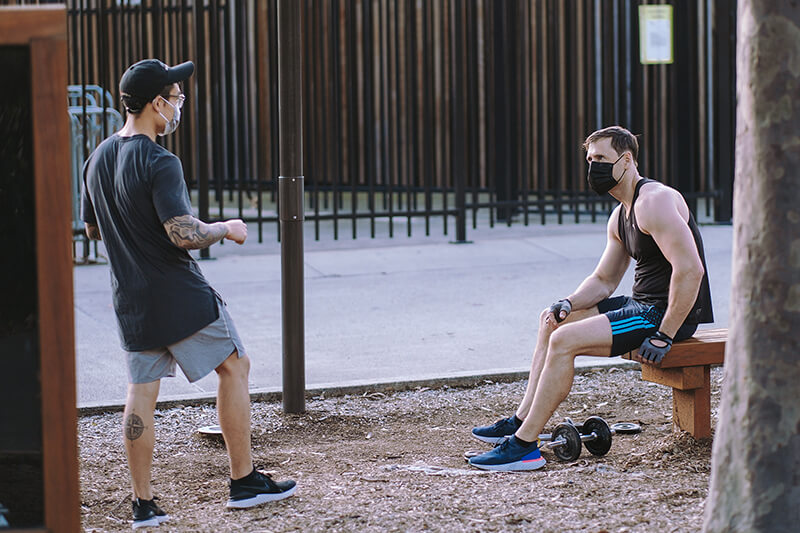June 29, 2020
Masks can make communicating tricky. Here are ways to make it easier.

Learning how to communicate effectively while wearing facial coverings can be a challenge. Shannon Van Hyfte, a clinical associate professor of audiology and director of the M.D. Steer Audiology Clinic at Purdue University, has some tips to make communicating easier. (Stock image)
WEST LAFAYETTE, Ind. — As wearing facial coverings and masks becomes the new normal during the COVID-19 pandemic, learning how to communicate effectively while wearing them can be a challenge.
That’s especially true for individuals who are deaf or hard of hearing, says Shannon Van Hyfte, a clinical associate professor of audiology and director of the M.D. Steer Audiology Clinic in Purdue University’s College of Health and Human Sciences.
“We usually tell people who are trying to communicate with someone with a hearing impairment not to cover their face, and now we’re living in a world where everyone needs to be covering their face,” Van Hyfte says. “It’s posing a unique challenge to people with hearing loss.”
Wearing facial coverings makes speech signals harder to hear, Van Hyfte says. It also reduces nonverbal cues from facial expressions and the ability to read lips.
“Everyone is having to work a lot harder to find those signals we use when we communicate,” she says. “I hope this is teaching us to be more patient when communicating with others. Right now, we’re all experiencing what it’s like to not hear as well as we’d like to, and I hope that makes us more understanding toward people with hearing loss.”
For individuals who wear hearing aids, getting a mask to fit properly over their ears also is a challenge, Van Hyfte says. She recommends that they wear a mask with an extender to make sure it fits securely without interfering with the hearing aid.
Van Hyfte, who sees patients regularly and teaches Purdue audiology students how to interact with patients, has the following tips to help with communication in a masked world – especially with those who are hearing-impaired.
Pausing and slowing down. Pausing between sentences while conversing with another person lets the other person keep up – and it allows for better breath support.
Keeping a level volume. While the other person may have trouble hearing and understanding you, Van Hyfte says, raising your voice isn’t necessarily helpful. “It can really degrade the signal of your voice, making it that much harder to hear,” she says. Keeping your voice at a consistent, level volume will make it easier to communicate.
Eliminating background noise. Try to move to a quieter area, away from background noise and distractions, if possible.
Other forms of communication. Van Hyfte suggests that when communicating with someone with a hearing impairment, ask how they’d prefer to communicate. Using an app or pencil and paper can sometimes be easier and more effective.
About Purdue University Department of Speech, Language, and Hearing Sciences
Purdue Speech, Language, and Hearing Sciences is a top-ranked department (No. 3 in Speech-Language Pathology and No. 9 in Audiology; U.S. News & World Report), with research and clinical efforts to mechanistically investigate and treat a variety of hearing, speaking, language, and swallowing disorders. The department’s state-of-the-art research and clinical laboratories facilitate cutting-edge scientific discoveries and a committed engagement with citizens of Indiana through top-quality clinical service delivery. The department supports stellar education of its students through four pre-eminent degree programs. Visit https://www.purdue.edu/hhs/slhs/ to learn more.
About Purdue University
Purdue University is a top public research institution developing practical solutions to today’s toughest challenges. Ranked the No. 6 Most Innovative University in the United States by U.S. News & World Report, Purdue delivers world-changing research and out-of-this-world discovery. Committed to hands-on and online, real-world learning, Purdue offers a transformative education to all. Committed to affordability and accessibility, Purdue has frozen tuition and most fees at 2012-13 levels, enabling more students than ever to graduate debt-free. See how Purdue never stops in the persistent pursuit of the next giant leap at purdue.edu.
Writer: Abbey Nickel, 740-326-0481, nickela@purdue.edu
Source: Shannon Van Hyfte, svanhyff@purdue.edu

